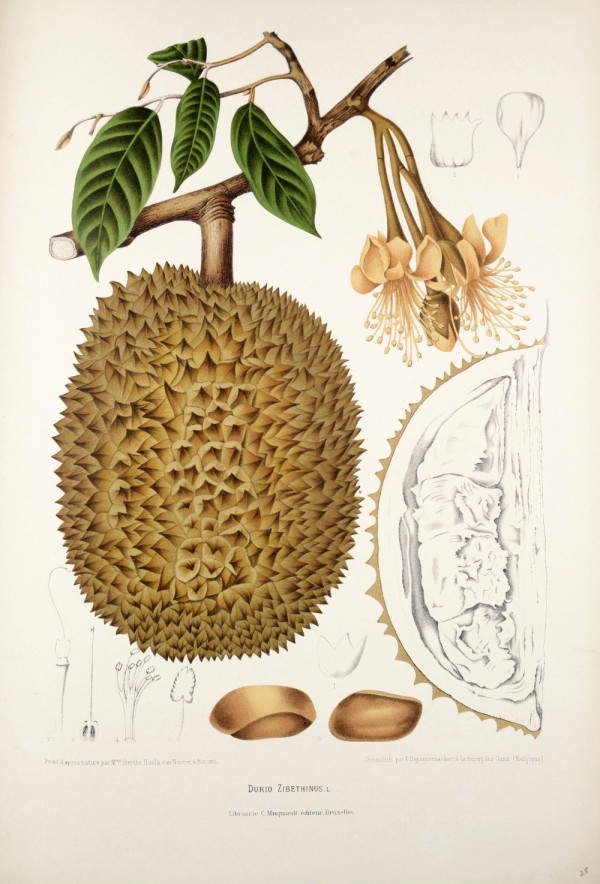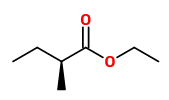Durio zibethinus L. - syn.Durio acuminatissimus Merr. - Malvaceae - durian, Durian, Zibetbaum
Evergreen tree, 20-40m high, believed to be native to Borneo and Sumatra, cultivated in Asia. „Apart from variants of the word „durian“ in native dialects, there are few other vernacular names, though the notorious odor has given rise to the unflattering terms, „civet cat tree“, and „civet fruit“ in India and „stinkvrucht “ in Dutch. Nevertheless the durian is the most important native fruit of southeastern Asia and neighboring islands.“ http://www.hort.purdue.edu/newcrop/morton/durian_ars.html
„As with other durian species, the edible flesh emits a distinctive odour that is strong and penetrating even when the husk is intact. Some people regard the durian as having a pleasantly sweet fragrance; others find the aroma overpowering and revolting. The smell evokes reactions from deep appreciation to intense disgust, and has been described variously as rotten onions, turpentine, and raw sewage. The persistence of its odour has led to the fruit's banishment from certain hotels and public transportation in Southeast Asia.“ http://en.wikipedia.org/wiki/Durio_zibethinus
„Volatile compounds in durian consisted of a large number of sulfur-containing compounds, which included diethyltrisulfide, diethyldisulfide, dithiolane, dimetyl sulfide, and 3-methyl-thiozolidine. Nonsulfur compounds 2-methyl butanoate, butanedioic acid, and propyl-2-ethylbutanoate were also abundant.“
[Postharvest survey of volatile compounds in five tropical fruits using headspace-solid phase microextraction (HS-SPME). Laohakunjit, N., Kerdchoechuen, O., Matta, F. B., Silva, J. L., Holmes, W. E., HortScience, Vol.42(2), 2007, 309-314]
„An aroma extract dilution analysis applied on the volatile fraction isolated from Thai durian… High FD factors were found for ethyl (2S)-2-methylbutanoate (fruity; FD 16384), ethyl cinnamate (honey; FD 4096), and 1-(ethylsulfanyl)ethanethiol (roasted onion; FD 1024), followed by 1-(ethyldisulfanyl)-1-(ethylsulfanyl)ethane (sulfury, onion), 2(5)-ethyl-4-hydroxy-5(2)-methylfuran-3(2H)-one (caramel), 3-hydroxy-4,5-dimethylfuran-2(5H)-one (soup seasoning), ethyl 2-methylpropanoate (fruity), ethyl butanoate (fruity), 3-methylbut-2-ene-1-thiol (skunky), ethane-1,1-dithiol (sulfury, durian), 1-(methylsulfanyl)ethanethiol (roasted onion), 1-(ethylsulfanyl)propane-1-thiol (roasted onion), and 4-hydroxy-2,5-dimethylfuran-3(2H)-one (caramel). Among the highly volatile compounds screened by static headspace gas chromatography-olfactometry, hydrogen sulfide (rotten egg), acetaldehyde (fresh, fruity), methanethiol (rotten, cabbage), ethanethiol (rotten, onion), and propane-1-thiol (rotten, durian) were found as additional potent odor-active compounds.“
[Characterization of the major odor-active compounds in Thai durian (Durio zibethinus L.‘Monthong’) by aroma extract dilution analysis and headspace gas chromatography–olfactometry., Li, J. X., Schieberle, P., Steinhaus, M., Journal of agricultural and food chemistry, 60(45), 2012, 11253-11262]
„Application of the approach to durian pulp resulted in high odour activity values (OAV = concentration/odour threshold) with ethanethiol (OAV 480000) being the most potent odorant, followed by methanethiol (OAV 45000), propane-1-thiol (OAV 6300), and hydrogen sulphide (OAV 330).“
[Li, Jia-Xiao, Peter Schieberle, and Martin Steinhaus. „Development of stable isotope dilution assays for the quantitation of the food odorants hydrogen sulphide, methanethiol, ethanethiol, and propane-1-thiol and application to durian (Durio zibethinus L.) pulp.“ European Food Research and Technology 243.1 (2017): 69-79]
„In combination with data recently reported for hydrogen sulfide and short-chain alkanethiols, OAVs > 1 were obtained for 19 compounds, among which ethyl (2S)-2-methylbutanoate (fruity; OAV 1700000), ethanethiol (rotten onion; OAV 480000), and 1-(ethylsulfanyl)ethane-1-thiol (roasted onion; OAV 250000) were the most potent, followed by methanethiol (rotten, cabbage; OAV 45000), ethane-1,1-dithiol (sulfury, durian; OAV 23000), and ethyl 2-methylpropanoate (fruity; OAV 22000). Aroma simulation and omission experiments revealed that the overall odor of durian pulp could be mimicked by only two compounds, namely, ethyl (2S)-2-methylbutanoate and 1-(ethylsulfanyl)ethane-1-thiol, when combined in their natural concentrations.“
[Li, Jia-Xiao, Peter Schieberle, and Martin Steinhaus. „Insights into the key compounds of durian (Durio zibethinus L.‘Monthong’) pulp odor by odorant quantitation and aroma simulation experiments.“ Journal of agricultural and food chemistry 65.3 (2017): 639-647]
„Quantitation of ethionine in samples of different varieties (Monthong, Krathum, Chanee, and Kanyao) showed concentrations (621-9600 μg/kg) in the same range but below the methionine concentrations (16100-30200 μg/kg). During fruit ripening, the ethionine concentration increased as well as the ethanethiol concentration. Final evidence for the role of ethionine as an ethanethiol precursor was provided by demonstrating the formation of (2H5)ethanethiol after adding (2H5)ethionine to durian pulp.“
[Fischer, Nadine S., and Martin Steinhaus. „Identification of an important odorant precursor in durian: first evidence of ethionine in plants.“ Journal of Agricultural and Food Chemistry 68.38 (2019): 10397-10402]

Hoola van Nooten, B., Fleurs, fruits et feuillages choisis de l’ille de Java: peints d’apres nature, t.28 (1880)
http://plantgenera.org/species.php?id_species=365862

